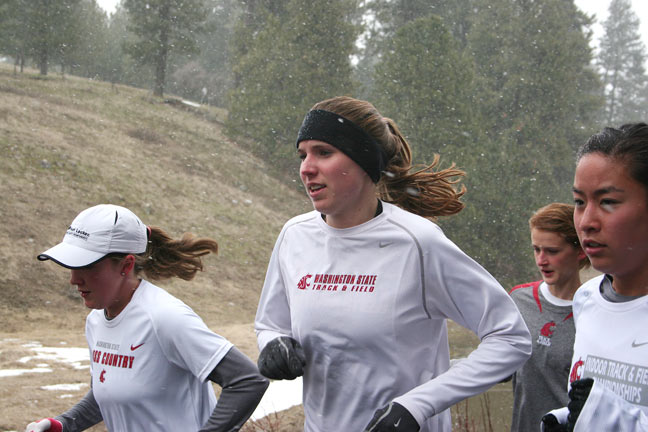On a summer morning, the sun’s first rays peep through my bedroom window, warming the dry air when I hear a tentative knock on my door.
“Marisa,” my dad whispers.
It’s 5:45 a.m. at the Sandoval house in Los Alamos, New Mexico. The pink morning glow and the patter of running shoes mean only one thing: It’s time to run.
For me, every summer day begins with a family run on picturesque trails carved into the high desert canyons and mesas of northern New Mexico’s Jemez Mountains. With my dad, Anthony Sandoval, leading the way, I run with my brothers and sisters. On a good day, we number eight athletes (including one golden retriever).
We traverse the same trails my dad trained on two decades ago for the Olympic Marathon Trials. From Bayo Canyon to Bandelier National Monument, these paths offer the rough landscape necessary for me to build my mental and physical strength throughout the summer days.
In August, as the morning air smells cold and purple asters bloom along the trail edges, the purpose behind my summer running suddenly shifts: I am training for the Washington State University cross country and track and field teams.
Four years ago, my love of running with my family grew to include a new family and a new landscape: the Cougars on eastern Washington’s panoramic Palouse.
A different, cool yellow sun creeps over the eastern hills, rays filtering through dried wheat stalks, illuminating the frosted edges of a quaint bridge on Johnson Road. Clad in running tights, our group of young men and women gather jovially, stirring under the watchful eye of our coach Jason Drake.
“Stretch, young Padawans!” he calls out as we shake out our morning stiffness.
It’s 8 a.m. on the Palouse. Every Sunday our cross country team escapes the confines of campus to explore the unpaved roads that curve through the surrounding hills.
The moment my feet crunch the gravel, time slows. Lost amidst towering hills and swaying wheat, a runner is threatened only by low-flying crop dusters and impatient pickups. Unlike New Mexico, where the mountains crash into the pure blue sky, the beauty around Pullman is subtle and pervasive. The hills provide a deep rhythm while I run, a harmony through constant repetition, color, and the cadence of silence. Following the training routes of legendary runners Gerry Lindgren ’68 and Bernard Lagat ’01, I trust the landscape to form my body as it did for those before me, one stride at a time.
From Johnson Road to Smoot Hill, Union Flat Road to Moscow Mountain, I find every run challenging and beautiful. Extreme cold in the winter, the brutal heat of summer, the Palouse always keeps me interested. Every day, despite the challenges—and because of them—I am tied more intimately to the landscape of the Palouse.
Running with my Cougar family has reinforced in me persistence, courage, and heart, first introduced to me by my family. These traits are fostered by my coaches and teammates. By running on the unending Palouse, I form my character as an athlete, a student, and a person.
In June, the NCAA track and field season will end. My coaches will hang up their stopwatches, and I will hang up my racing spikes and return to my family in New Mexico. But next August, just in time for harvest, my Cougar family will re-unite in Pullman. I can guarantee that solitary combine driver will earn a wave as I run again through the Palouse.
 “The hills provide a deep rhythm and the cadence of silence.”
“The hills provide a deep rhythm and the cadence of silence.”
(Photo Tobias Walther)
